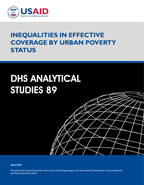There is no printed copy available to order.
Abstract:
Previous research has established intra-urban
disparities in intervention coverage and
quality of care between the urban poor and
non-poor. However, effective coverage (that
is, combining measures of need for a health
service with coverage and quality into one
metric), is increasingly being used to
evaluate the performance of urban health care
systems. This study examined inequities in
antenatal care (ANC) and sick child care
effective coverage by urban poverty status in
six countries: Afghanistan, Democratic
Republic of the Congo (DRC), Ethiopia, Haiti,
Nepal, and Tanzania. Inequalities were
assessed using previously developed measures
that combine data from Demographic and Health
Surveys (DHS) and Service Provision
Assessment surveys. Results showed that more
than half of urban women of reproductive age
in Afghanistan and Ethiopia, and more than
half of urban children under 5 in Afghanistan
and DRC, were living in urban poor clusters.
In contrast, fewer than 6% of urban women of
reproductive age and fewer than 12% of urban
children under 5 in Haiti, Nepal, and
Tanzania lived in urban poor clusters. When
we calculated effective coverage, results
differed between the ANC and sick child care
cascades. For ANC, statistically significant
disparities in quality-adjusted coverage (the
last of four steps in the cascade) were
found in DRC, Ethiopia, and Haiti. The
differences in urban poor versus non-poor
effective coverage were driven by
statistically significant differences in two
DHS component measures: service contact and
receipt of complete intervention. No
statistically significant disparities were
found in sick child effective coverage
by urban poverty status in any of the
countries. Policymakers and program managers
should consider approaches to disaggregating
effective coverage measures by urban poverty
status whenever possible to identify urban
populations most at risk.
 Inequalities in Effective Coverage by Urban Poverty Status (PDF, 2282K)
Inequalities in Effective Coverage by Urban Poverty Status (PDF, 2282K)
 Effective Coverage in Urban Poor Areas (AS89) - Analysis Brief
Effective Coverage in Urban Poor Areas (AS89) - Analysis Brief
